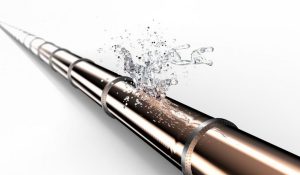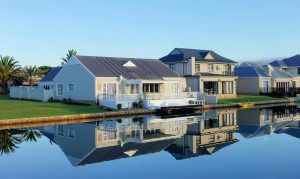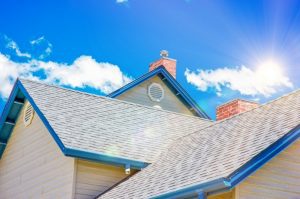Contents
ABC Science environment reporter Nick Kilvert
On a single stretch of beach on Cape York Peninsula, on Australia’s north-eastern tip, volunteers spend four days collecting more than 7 tonnes of trash. The haul includes 1,000 cigarette lighters, 2,280 toothbrushes, 3,320 plastic drink bottles, 5,500 thongs (flip-flops) and miles of fishing nets.
A year ago they collected around 3 tonnes. Next year a new group of volunteers will come back to find the same stretch of sand blanketed in trash.
Our remote northern beaches bear the symptoms of a global waste pandemic that many will understandably view as an insurmountable curse; efforts to clean it up, well-intentioned but ultimately futile.
(Research by marine scientists tells us that by 2050, there will be more plastic, by weight, in our oceans than marine life!)
But a beach heaving with the world’s plastic detritus can also look like an opportunity to Professor Veena Sahajwalla.
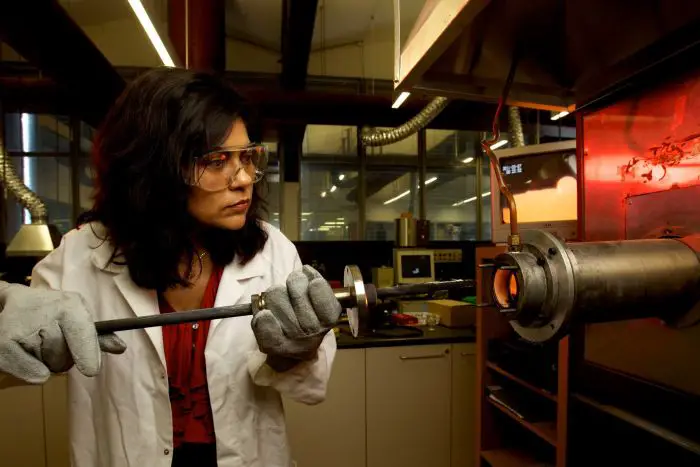
The very concept of waste, according to Veena, needs to be completely revolutionised.
“We’ve got to value waste as a resource. We really shouldn’t have to send any overseas,” she says.
“It’s an important thing to be prepared to not just see it as a problem but also to see it as a fantastic opportunity.”
Veena’s team at the University of New South Wales are developing micro-factories: small, modular recycling plants capable of turning a variety of waste into usable materials.
Their micro-factories are capable of turning plastics into filaments: long strands that form the “ink” in 3D printers and can be moulded into anything from car parts and everyday household items, to hardware, tools and medical equipment.
“We’re looking at different types of waste plastics, it doesn’t have to be the stock-standard PET bottles,” Veena says.
“E-waste like printers for example, and things like CDs — all of these we have shown that you can convert them into filaments.”
Micro-factories offer ‘the ultimate empowerment
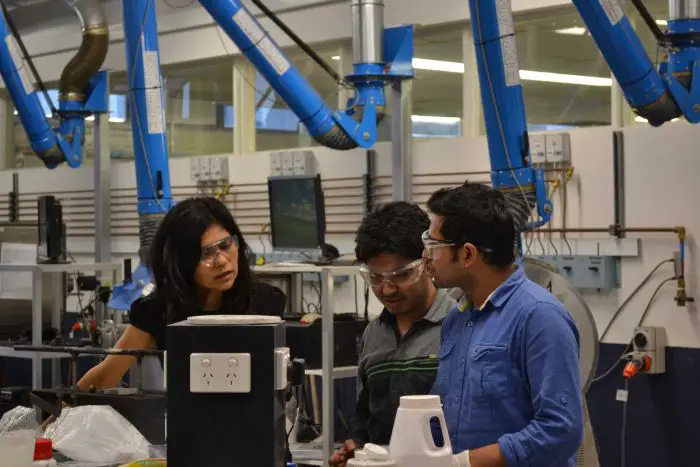
Growing up in Mumbai — one of the world’s largest industrial centres, Veena developed a fascination with the things people discard.
“Kids collect stamps, I used to collect rubbish — little glass bottles and little things that to me were like, ‘OMG this is so cool!'”
Her micro-factories are also being developed to produce metal alloys from e-waste such as circuit boards, and to reform glass, food packaging and textiles.
“The system needs to be flexible at the micro-factory level and to have different modules in order to process different types of waste materials,” she says.
The idea, according to Veena, is to enable recycling to happen on a scale that allows rural towns and communities to turn their waste into a valuable commodity.
Remote communities like Lockhart River or Bamaga in Cape York for example, might be able to harvest the tonnes of rubbish that wash up on their beaches and convert that waste into useful products with 3D printing technologies. (A Chinese entrepreneur is even printing 3D homes using waste materials!)
According to Veena, Harvesting waste and turning it into something that can be used locally or exported is a disruption to manufacturing, in a similar way that Uber is a disruption to transport, or Airbnb is to accommodation.
“To me that is the ultimate empowerment — to be locally producing [materials] yourself,” she says.
“Let’s be exporting the products out to the world … filaments are something that everybody in the world will be using as people do more and more 3D printing.”
Her team are launching their micro-factories alongside industry partners later this year.
The ‘accidental environmentalist’ building a plastic-bottle house
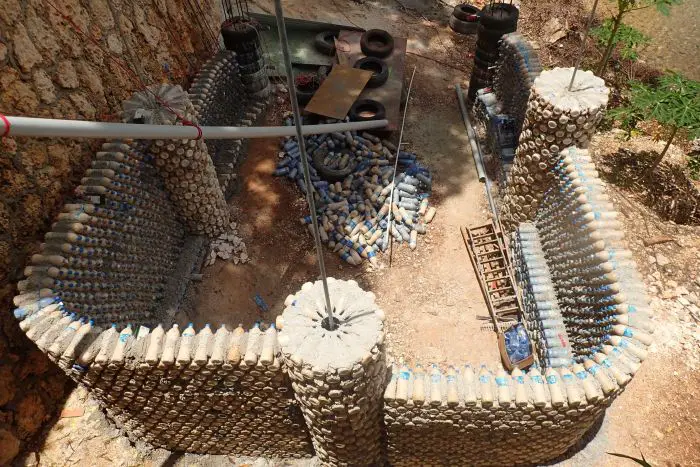
Meanwhile, in Tonga, Phil Smith is coming at the waste issue from an entirely different angle.
Phil’s phone keeps dropping out mid-conversation, which he says is all part and parcel of living in Tonga.
“The spinoffs for being a smartarse have been unbelievable. I just can’t believe it,” he says in between drop-outs.
Running a successful whale-swimming business, Phil who worked for 38 years on a jackhammer in Sydney, was looking for a suitable building material to upgrade his own house and guest accommodation when he stumbled across the idea of building with plastic bottles.
“A couple of photos just struck me — the finishes, how beautiful they were, I thought, ‘Well, why not? There’s plenty of rubbish around the place, plenty of plastic bottles, plenty of willing helpers’,” he says.
Building with bottles involves filling them with a rammed mix of limestone dust and sand — made out of crushed glass — and then setting the bottles within a solid mortar mix.
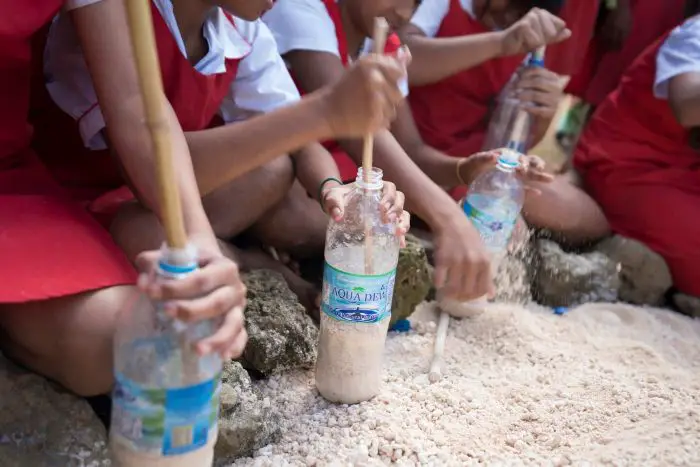
The resulting structure is said to be stronger than an equivalent brick wall, earthquake resistant due to the flex in the plastic, and has the added benefit of removing significant volumes of waste from the environment.
But for Phil, the ecological benefits have paled in comparison to the social outcomes he says have inadvertently sprung out of choosing to build a plastic-bottle house.
“A girl who’s a very good environmentalist said to me, ‘You’re just an accidental environmentalist. You’ve done more for Tonga than anybody because of your smartarse idea’,” he said.
Needing upwards of 100,000 filled plastic bottles for the walls of his building, Phil enlisted the help of local school kids, adding 60 cents per bottle to a fund which he used to buy them laptop computers for their classrooms.
But as he began talking to principals and teachers, he discovered that there were some more basic items than computers that the schools were lacking.
“We think it’s funny coming from Australia, but all they wanted was a mower … because it was costing them 150 local dollars every fortnight to get the lawn mowed, and that was the principal’s whole budget,” Phil says.
“In another school all they wanted was carpet. I couldn’t find carpet, so their carpet’s linoleum. Another school lost power to nine of their 12 rooms in cyclone Waka in 2002, so they haven’t had power for 15 years. Now they have.”
5-star aspirations could catch the eye of the king
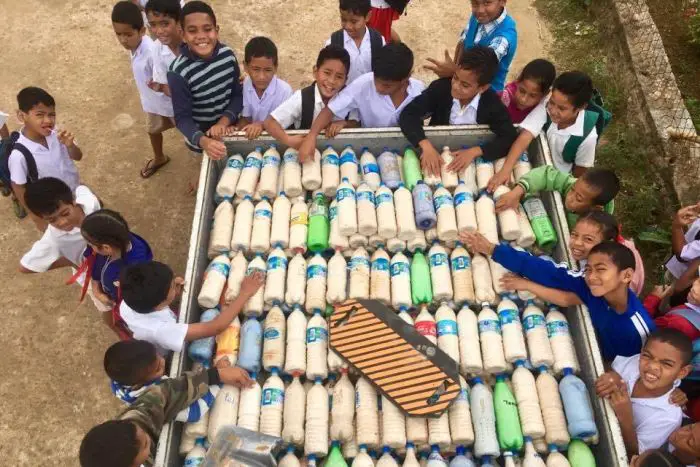
Once the kids saw the rewards they were getting for their hard work, Phil says they began clearing the streets and shorelines for rubbish, and entire family groups got involved as well.
“There’s one old guy in one group, he’s a bit like a horse you’d put in the bottom paddock because he’s too old to work on the plantations so he’s just sitting at home,” he says.
“Now he’s filling bottles. When I rock up he smiles, you see both his teeth shining. Even if that just gives him a year or two of that bit of self-worth, well that’s fantastic to me.”
When Phil dropped the mower off at the school, the principal organised a snap presentation.
“The emotion of these kids, it was six at night, they rang the bell, all the parents and kids came along, they all sat down neatly at the front and then started singing songs,” he says.
“The town officers said a couple of prayers. The headmaster, he was crying making a speech just saying that the kids worked hard for this, they got blisters on their hands, they realised that they can work to achieve anything.”
Phil’s building will eventually have enough space for around 20 guests, a presentation room for workshops, and his own accommodation. He has so far stockpiled 35,000 bottles, and needs another 65,000 to complete the build.
As well as the plastic bottles, he’s imported a machine that crushes glass bottles into fine sand that he is using in the mortar mix. He estimates that he’ll use around 400,000 glass bottles altogether.
Although he is aiming to make the accommodation as near to 5-star as possible, he says a local custom is giving him some room for pause.
“It looks directly at the King’s house. When he’s in town he can look down at my place and in Tonga law if the King likes it he can come and take it. So I just hope he doesn’t like it too much.”
Could a house of old tyres be the future of efficient design?
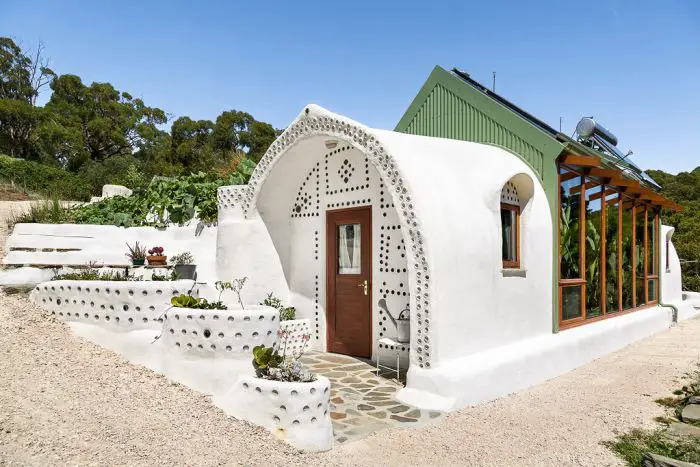
When Martin Freney came across a bunch of books on earthships in 2007, he says the concept “just made sense”.
“I think it was the environmental impacts [of house building] that were a big issue for me,” he says.
Earthships are a building design that have struggled to take off in Australia due to strict building regulations.
Pioneered by US architect Michael Reynolds, an earthship incorporates thick insulating walls usually set into a hillside, built from used car tyres filled with rammed earth. (Hundreds of millions of tyres end up in landfill – or are simply dumped – every year. Spontaneous fires at tyre dumps are an environmental nightmare!)
Internal walls are typically built from earth products such as mudbrick and with materials such as glass bottles inlaid. And within these, is a greenhouse where food is grown on recycled grey water, with passive solar and thermal systems providing heat and energy.
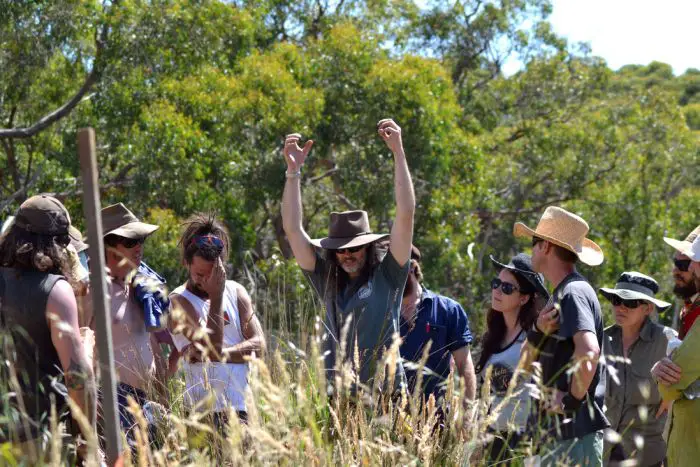
In 2011, Martin headed to the US to study the thermal properties of earthships, comparing them to more standard construction methods as part of his PhD research. His findings convinced him that the innovative design is the direction that housing construction needs to take.
Martin set about constructing an earthship at Ironbank in South Australia that could comply with Australia’s strict building codes.
He says he had to pick his way through building certifiers until he found one who was willing to do a bit of research.
“There are different ways of achieving compliance,” Martin says.
“[We found] a private certifier that had the knowledge and resources and was interested in the idea [enough] to look into the national construction code.”
Once Martin found the right certifier, he says getting the building to comply was relatively straight forward, but he ran into trouble with his grey water system.

Although Martin initially had the system pumping into the greenhouse, council ordered it to be removed over health and odour concerns.
“I was foolish enough to brag about it in a newspaper,” he says.
Despite the compromise, Martin says his resulting earthship, which is now run as a bed and breakfast, has remained true to the principals of sustainable design.
“People are coming and enjoying it and experiencing it and, overwhelmingly, they want one, or they don’t want to leave.”
This article was originally published by ABC Science


